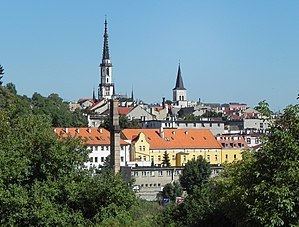Time zone CET (UTC+1) Area 13.67 km² Local time Sunday 8:46 PM | Elevation 280 m (920 ft) Postal code 57-200 and 57-201 Population 16,086 (2011) | |
 | ||
Weather 16°C, Wind NW at 10 km/h, 61% Humidity Voivodeship | ||
Ząbkowice Śląskie [zɔmpkɔˈvit͡sɛ ˈɕlɔ̃skʲɛ] (German: Frankenstein in Schlesien) is a town in Lower Silesian Voivodeship in south-western Poland. It is the seat of Ząbkowice Śląskie County, and of the smaller administrative district (gmina) called Gmina Ząbkowice Śląskie.
Contents
Map of Z%C4%85bkowice %C5%9Al%C4%85skie, Poland
The town lies approximately 63 kilometres (39 miles) south of the regional capital Wrocław. As of 2011, it had a population of 16,086.
History
The town was established by Duke of Silesia Henry IV Probus as Frankenstein in the early 13th century, following the Mongol invasion. It was sited on a piece of land that belonged partly to the episcopal lands of Procan (German Protzan, modern Zwrócona) and partly to the Monastery at Trzebnica (German Trebnitz). The town was located exactly halfways between the sites of two previously existing towns that had failed to attract enough settlers: Frankenberg and Löwenstein, and inherited its German name from both.
Its positioning on the so-called Königstraße (King's Road) between Prague and Breslau, not too far from the commercially important city of Glatz would favour the development of the town. The town received municipal rights around 1280, the first mention of civitas Frankenstein is dated January 10, 1287. As from 1335 it belonged to Bohemia, and from 1742 to Prussia.
In the early 17th century the plague killed about one third of the population, and it has been speculated that events at that time may have inspired the Frankenstein story.
In 1858 the town burned down and had to be rebuilt. On this occasion, the upper part of the 15th-century leaning tower was reconstructed in a straight manner. The town was a county seat from 1816 to 1945. After World War II the town passed to Poland (along with most of Silesia) and was renamed Ząbkowice Śląskie in 1946, after the German population had fled or been expelled.
Tourist attractions
Ząbkowice Śląskie is often called the Silesian Pisa as it is known for its Leaning Tower (Krzywa Wieża), which is one of the main attractions in this part of Poland. However, you will also among tourist attractions find 13th century fortifications and the ruins of a 14th-century castle. The Leaning Tower (Krzywa Wieża) 13th century fortifications Ruins of a 14th-century castle
